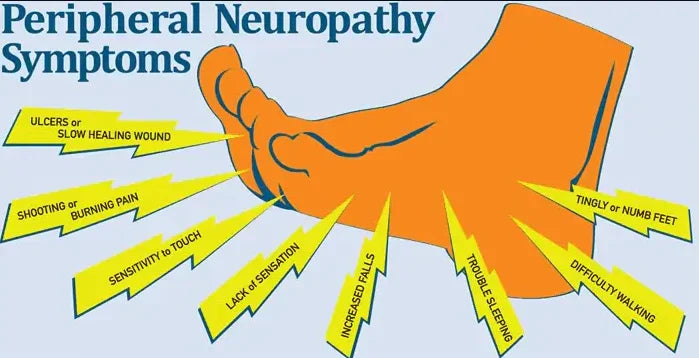Small fibre neuropathy (SFN) is a condition that affects the small nerve fibres in your body. These fibres are responsible for transmitting pain and temperature sensations. When they are damaged, they can lead to a range of symptoms that can significantly affect your quality of life. Understanding the symptoms and treatment options for small fibre neuropathy is crucial for managing this condition effectively.
Small fibre neuropathy is a type of peripheral neuropathy. It specifically targets the small nerve fibres, which are thin nerves that extend to your skin, organs, and sensory receptors. These fibres play a crucial role in how we perceive temperature and pain.
 Causes of Small Fibre Neuropathy
Causes of Small Fibre Neuropathy
Several factors can contribute to the development of small fibre neuropathy. Some of the most common causes include:
-
Diabetes: High blood sugar levels can damage nerve fibres over time, leading to neuropathy.
-
Genetic Disorders: Some inherited conditions can cause nerve damage.
-
Autoimmune Diseases: Conditions like lupus or Sjögren's syndrome can attack nerve fibres.
-
Infections: Certain infections, such as HIV or Lyme disease, can lead to neuropathy.
-
Toxins: Exposure to certain chemicals or heavy metals can damage nerves.
-
Idiopathic Causes: In some cases, the cause remains unknown.
Symptoms of Small Fibre Neuropathy
The symptoms of small fibre neuropathy can vary from person to person, but they typically include:
-
Burning Pain: A common symptom that can feel like a burning sensation in your feet or hands.
-
Tingling or Numbness: A feeling of pins and needles, often starting in the toes or fingers.
-
Temperature Sensitivity: An increased sensitivity to hot or cold temperatures.
-
Weakness: Muscle weakness can occur, although it is less common.
-
Autonomic Symptoms: These may include issues with sweating, digestion, or blood pressure regulation.
 Diagnosing Small Fibre Neuropathy
Diagnosing Small Fibre Neuropathy
Diagnosing small fibre neuropathy often involves a combination of clinical evaluation and specialised tests. Your doctor may conduct a physical examination and ask about your symptoms and medical history. Additional tests might include:
-
Skin Biopsy: A small sample of skin is taken to examine the nerve fibre density.
-
Quantitative Sudomotor Axon Reflex Test (QSART): This test measures the nerves that control sweating.
-
Nerve Conduction Studies: These tests evaluate the function of larger nerve fibres, often used to rule out other types of neuropathy.
Treatment Options for Small Fibre Neuropathy
While there is no cure for small fibre neuropathy, several treatment options can help manage the symptoms and improve quality of life.
Medications
-
Pain Relievers: Over-the-counter medications such as acetaminophen or ibuprofen can help manage mild pain.
-
Prescription Medications: Drugs like gabapentin or pregabalin are often prescribed for nerve pain.
-
Topical Treatments: Creams containing capsaicin or lidocaine can provide localised pain relief.
Lifestyle Changes
-
Supportive Shoes: Wearing properly fitting neuropathy shoes or diabetic shoes can help reduce foot pain and improve balance. Look for shoes with good arch support and cushioned soles.
-
Exercise: Regular physical activity can improve muscle strength and help maintain a healthy weight.
-
Diet: A balanced diet rich in vitamins and minerals can support nerve health.
Alternative Therapies
-
Acupuncture: Some people find relief from symptoms with acupuncture treatments.
-
Physical Therapy: A physical therapist can provide exercises and strategies to maintain mobility and reduce pain.
Importance of Supportive Footwear
Choosing the right footwear is essential for those with small fibre neuropathy. Neuropathy shoes are designed to provide extra support and cushioning, which can help alleviate foot pain and prevent further complications.
Features of Good Neuropathy Shoes
-
Cushioned Insoles: These help absorb shock and reduce pressure on the feet.
-
Roomy Toe Box: Provides ample space to prevent friction and pressure sores.
-
Arch Support: Essential for maintaining proper foot alignment and reducing pain.
-
Adjustable Straps or Laces: Allow for a customised fit.
Living with Small Fibre Neuropathy
Managing small fibre neuropathy involves a combination of medical treatments and lifestyle adjustments. Staying informed about your condition and working closely with your healthcare provider can help you manage symptoms effectively. Regular check-ups and monitoring can prevent complications and ensure you receive the most appropriate care.
Support and Resources
Connecting with others who have small fibre neuropathy can provide emotional support and practical advice. Consider joining support groups or online communities to share experiences and learn from others facing similar challenges.
Conclusion
Small fibre neuropathy can be a challenging condition, but understanding its symptoms and treatment options can empower you to take control of your health. By working with your healthcare provider and making informed lifestyle choices, you can manage the symptoms and maintain a good quality of life. Remember, supportive footwear and proactive management are key components in living well with small fibre neuropathy.








